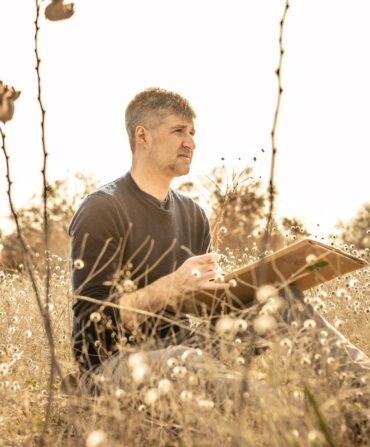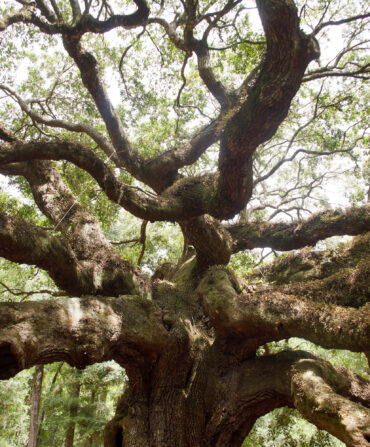Land & Conservation
Chasing the Ivory-Billed Woodpecker
The struggle to prove the majestic bird still exists has obsessed believers and exasperated doubters for a century. Now photographer Bobby Harrison is racing to document the species once and for all before the government declares it extinct
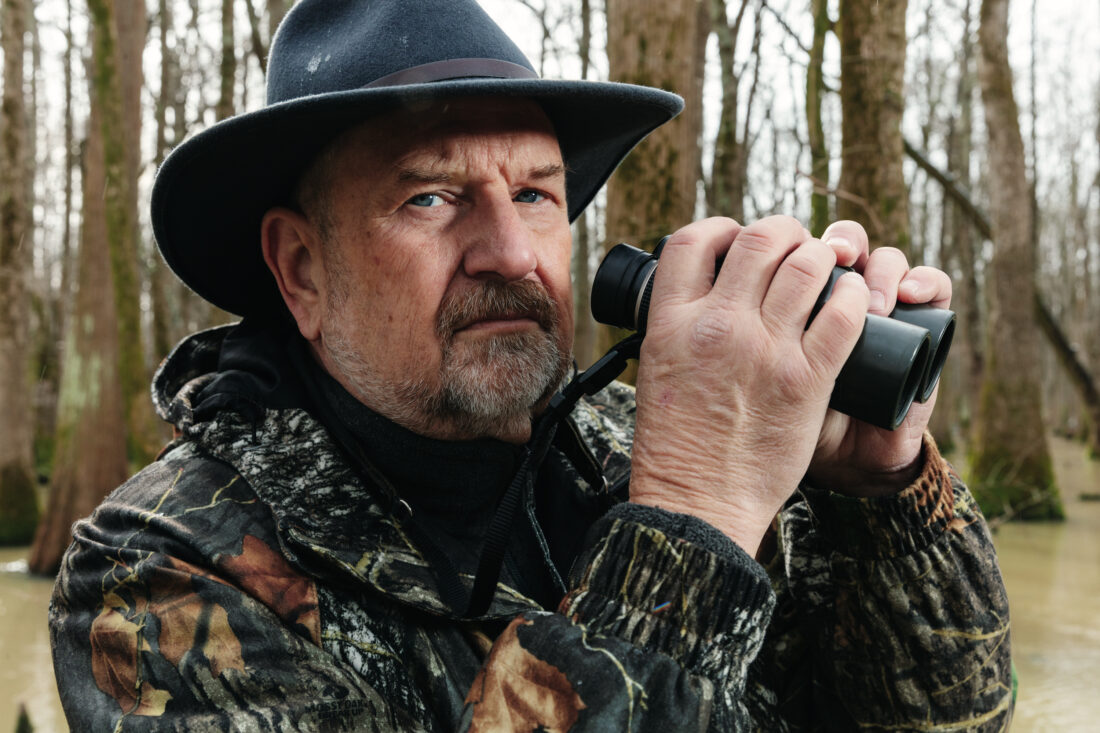
“The Ivory-bill is a product of the great force of evolution acting on American bird life in ages past, to produce in our southeastern United States the noblest woodpecker of them all…”
—Arthur Allen, founder of the Cornell Lab of Ornithology
The bird has many names, often divinely inspired: the Lord God Bird, the Lazarus Bird, the Ghost Bird, the Grail Bird. Bobby Harrison is a religious man, but he doesn’t like any of them. He prefers to call it what it is: an ivory-billed woodpecker. “Well,” he says with a shrug, “it is just a bird, after all.”

That might seem like an undersell for someone who on this steaming August day is preparing to shove off into the humid, murky shade of an Arkansas swamp on his two-thousandth-plus search for the ivorybill, whose last-agreed-upon sighting in the United States occurred in 1944. But Harrison’s undersell has the ring of the believer: To him, the ivorybill is, like any other bird, made of hollow bones, feathers, a bill. It doesn’t have celestial powers; it’s not a messenger from on high. Instead, it’s still out in the Southern wilds, doing bird things, flying around as it always has. Harrison will tell you all this because he’s seen one. Other people will tell you, very firmly, that he has not—and the clock is now ticking for him to persuade them otherwise.
Any day now, the U.S. Fish & Wildlife Service (USFWS) will decide whether to declare the ivorybill extinct, which would strip it of all protections and put an official death stamp on a species that has sparked a heated, century-long debate; captured imaginations; marred reputations; influenced the creation of Congaree National Park; and sparked infighting in the scientific community between those who demand hard proof and those who say the ivorybill has persisted against all odds, transformed by natural selection into a creature so quiet, so wary, and so elusive that producing a crisp photo or video of one is as difficult as spotting the bird in the first place.
Harrison numbers among the most ardent of the believers. At sixty-eight years old, the photographer returns time and again to this sliver of eastern Arkansas to try to secure an image of the bird. He’s done it before: He captured a video of an ivorybill less than three years ago.
The fast-moving bird appearing on that recording made headlines, but with the federal decision looming, he’s determined to produce irrefutable evidence. And so he continues his ritual of the last twenty years: Yesterday, he drove five hours from his home in Alabama to an Arkansas cypress swamp. This morning, he dons hip waders and outfits his canoe with a trolling motor, beef jerky, water, and camera gear, and casts a camouflage tarp over it all. Then he chugs quietly into the recesses of the wetland, determined to fulfill his mission and resurrect the bird once and for all. “I feel hopeful every time I go out,” he says. “The bird lives, and it needs to be documented.”
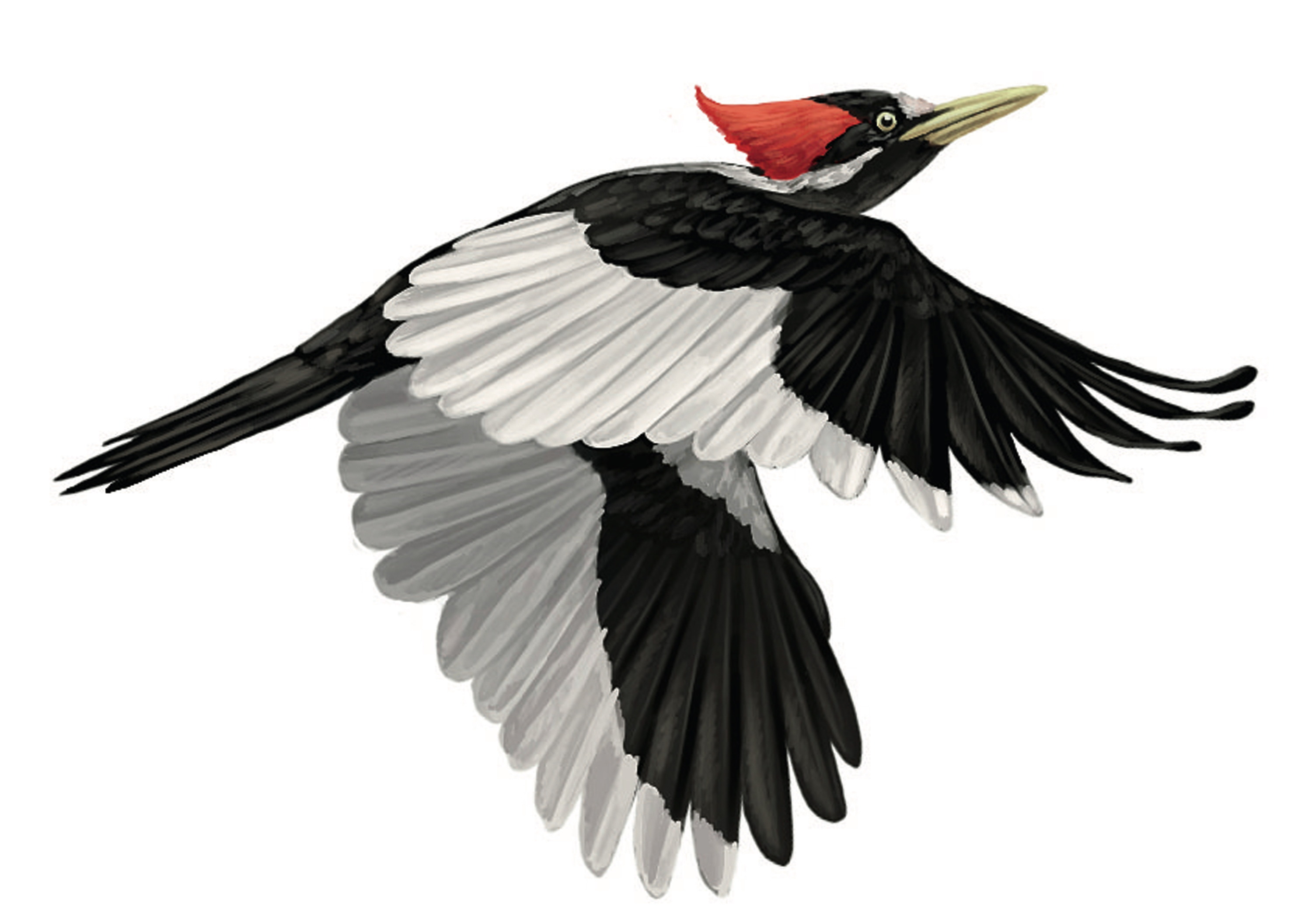
Perhaps the ivorybill was just too beautiful. With a sweeping suit of black and white feathers, dramatic crests in electric red on males and ebony on females, and a long pearly bill, it evolved to live in the wildest of landscapes—the swampy bottomland hardwood forests that stretch across the South, from East Texas to the Atlantic and as far north as Southern Illinois. With a wingspan of two and a half feet, the ivorybill was the country’s largest woodpecker, and its aspect inspired awe in all who encountered it, from Native Americans to early naturalists such as Mark Catesby and John James Audubon.
But to inspire awe also meant inspiring the need for possession. For as long as humans have had the tools to do it, we’ve killed the bird. Native Americans hunted it and traded it. Settlers hunted it and ate it. Collectors hunted it and stuffed it. Back when they carried guns instead of binoculars, ornithologists hunted it and studied it. And in the twentieth century, as the ivorybill became rare and then rarer still and its habitat continued to vanish, it amassed a following of devotees who pursued it into the deepest reaches of the swamps, praying for a glimpse and a sign that surely, surely, we hadn’t obliterated such a creature.
Bobby Harrison became one of those devotees at an early age. Growing up in Decatur, Alabama, he was shy, and often retreated within adventure stories and tales of exploration. Then, at fifteen, he received his first camera. Stepping behind that viewfinder banished his timidity, and the colorful, active forms of birds became his favorite subjects. “I always loved the thrill of hunting, but I never liked to kill,” he says. To aid in that hunt, he spent hours in libraries immersed in avian research, and in 1972, at age seventeen, he read a story that would launch a lifelong quest: a Life magazine feature detailing John Dennis’s search for the ivory-billed woodpecker through the dense woods of the Big Thicket in southeastern Texas.
Dennis, a respected ornithologist who had photographed ivorybills in Cuba in 1948, had reported that he’d seen the bird in the Big Thicket in 1966. But the ornithological community rejected his sighting, and Dennis would always chase what Harrison calls “that eight-by-ten glossy.” Harrison read the description of the difficult-to-plumb habitat and believed the critics had written off the woodpecker, and Dennis, too quickly. “It just seemed like the possibility was dismissed too soon,” he recalls.
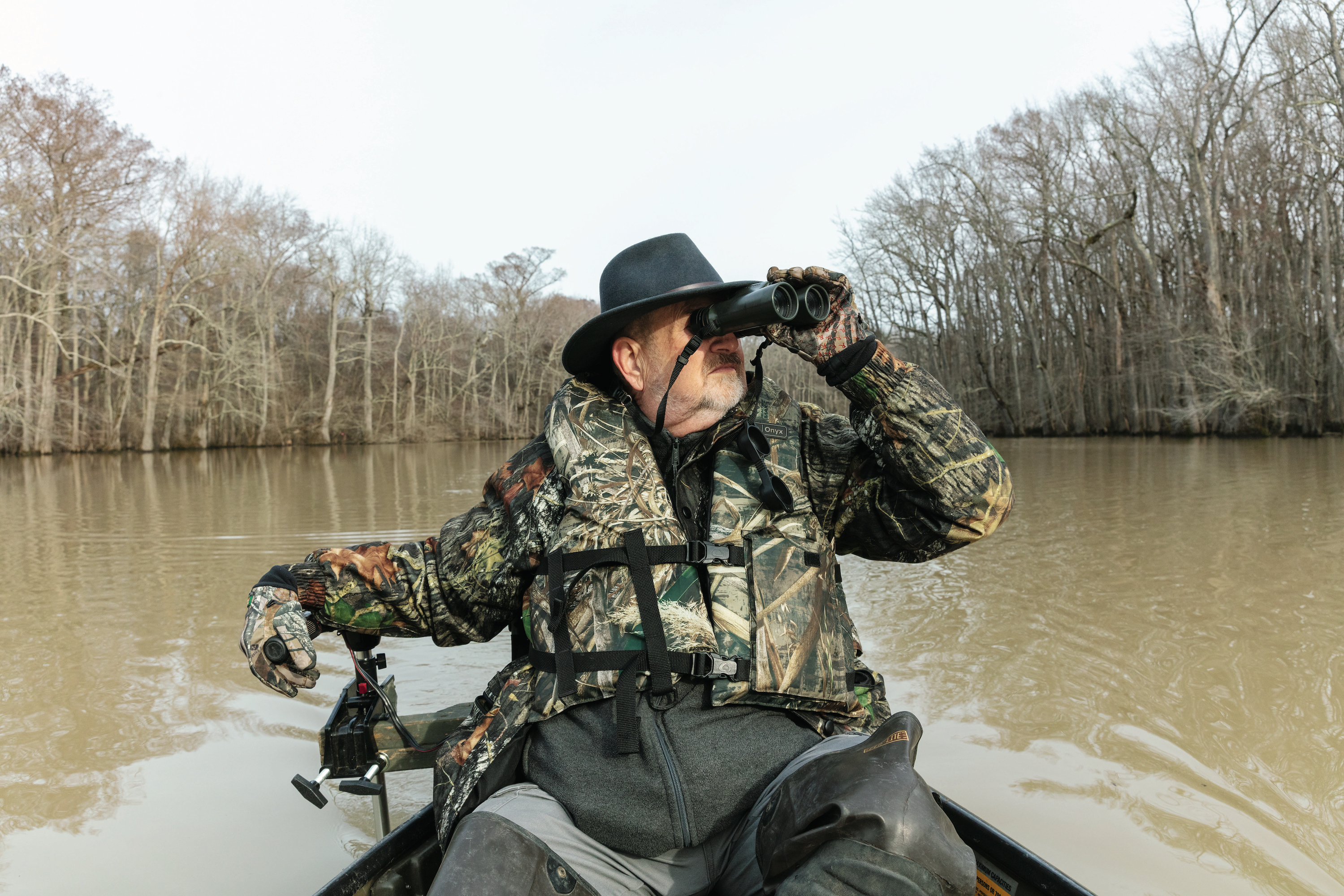
On the hunt for the ivorybill in an Arkansas swamp.
After all, ornithologists had been wrong before: By 1921, most already believed the bird to be extinct. Those with the American Museum of Natural History in New York had searched with no luck, but Arthur Allen, the founder of the Cornell Lab of Ornithology, kept looking. In 1924, he discovered a breeding pair in Florida. Ecstatic, he gave the couple time to nest and then returned to document them. But he found only muddy boot prints and an empty tree. Local taxidermists had heard the news, found the spot, and shot both birds.
But they proved not to be the last ivorybills, either. A state legislator shot another in the 1930s in the Singer Tract of northeastern Louisiana—an 81,000-acre swath of uninterrupted forest owned by the Singer sewing machine company—just to prove to the state Department of Wildlife and Fisheries that the bird still existed there. In 1935, Allen assembled a team to go into those same swamps and document the remaining birds. He and his colleague Peter Paul Kellogg took photographs, videos, and recordings that reveal the ivorybills’ strange, puppeteer-jerky movements; white-rimmed, uncanny eyes; nasal kent calls; and the signature double rap of their bills on wood, BAM-bam. He nominated a young ornithologist on the expedition, James Tanner, to conduct a three-year study on the species, in hopes of hatching a conservation plan to save them.
“Is the preservation of a glorious species that has taken millions of years to evolve worth ten dollars?” Allen wrote in the introduction to Tanner’s resulting book. “Is it worth ten million dollars? It is worth whatever we must pay to preserve it before it is too late.” In the end, though, the Louisiana habitat, the ivorybills’ last real stronghold, was lost. Singer sold the tract’s timber rights, despite the efforts of President Franklin D. Roosevelt and four governors to preserve the land, and loggers felled the ancient forest.
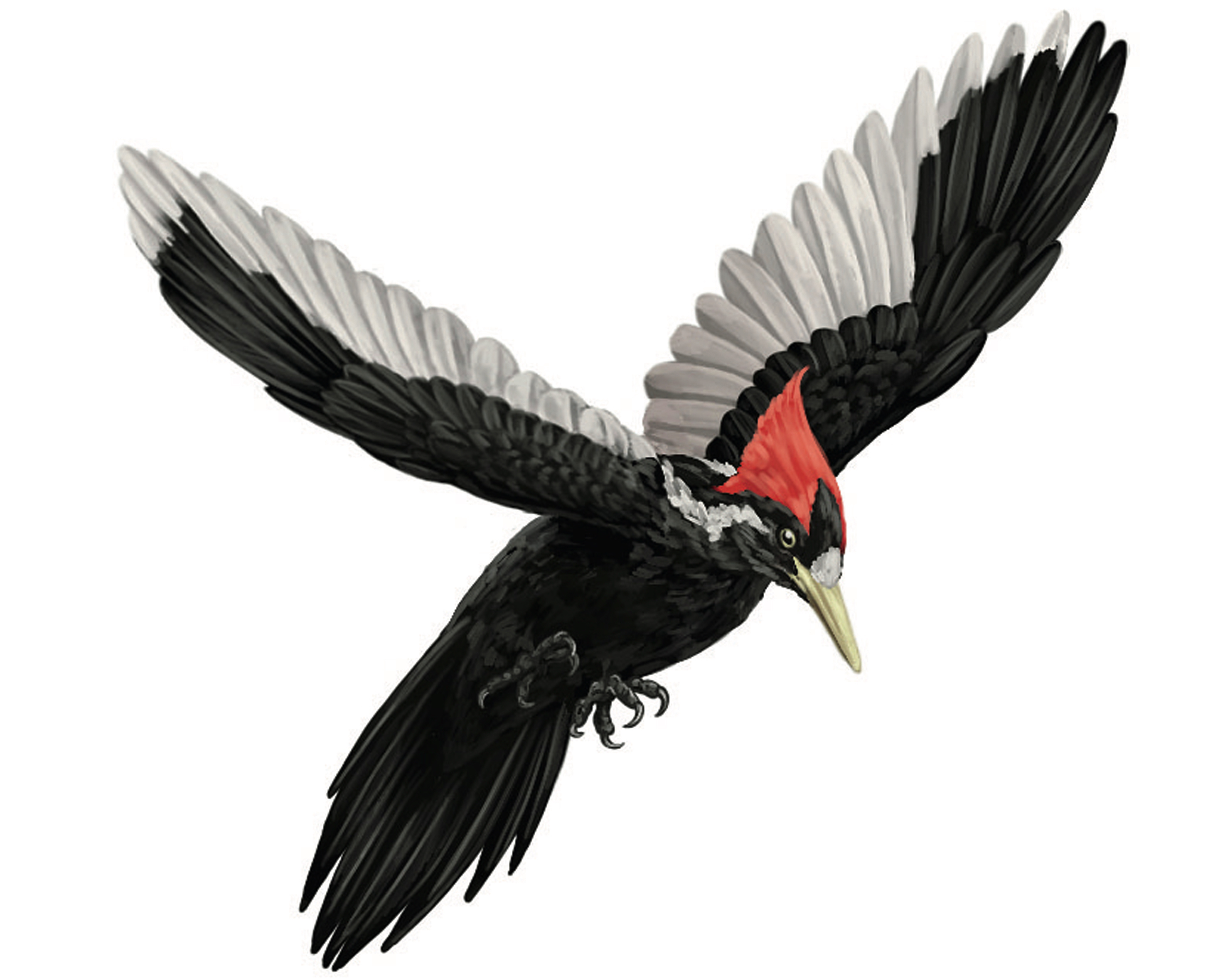
As Tanner wrote in his book, “Hunting for localities where Ivory-bills were, and in those localities trying to find the birds, was like searching for an animated needle in a haystack.” Harrison’s copy of that 1942 work, the road map for all who search, is well thumbed. He has underlined in red descriptions of the bird, its habitat, its markings, and its behavior—its flight, the way it scales bark off of trees to forage—and of how to distinguish it from its slightly smaller relative, the pileated woodpecker, whose similar features cause constant confusion and muddle all but the clearest views.
Armed with Tanner’s knowledge, Harrison at twenty-four took his first trip to Florida to look for the ivorybill. “I was agnostic about the bird at the time, and skeptical,” he recalls. “But I just knew that the habitat was still there, and I knew how hard it was to navigate.” That conviction—augmented by his love of the wild, cypress-buttressed forests, a deep hope that the bird had defied the odds, and a desire to prove the doubters wrong—kept him searching off and on for two and a half decades without claiming a sighting.
In between excursions, Harrison lived a full life. He met and married the love of his life, Norma, a game-for-adventure New Yorker with Puerto Rican roots, earned a master’s in media technology, and took a job teaching photography at Oakwood University, a historically Black school in Huntsville, Alabama. He and Norma welcomed two children, Robert and Whitney, and Harrison built their home outside the city himself from the ground up. University life afforded him plenty of time to parent and to pursue photography. Spring, summer, and fall breaks found him crouched under camouflage tarps on beaches or in forests to capture birds of all kinds, and he sometimes engineered his own devices to get the perfect shot. His photographs, which have appeared in Audubon, Living Bird, and other publications, look artistic, sentimental, impossibly sharp—the work of a Job-patient and single-minded man. “My favorite bird is the one that is behind my lens,” he says. Still, the ivorybill nagged. Whenever he was close to suitable habitat for the woodpecker, he would set out to search, on foot or by canoe, through environs John James Audubon called of “oozing, spongy, and miry disposition.”
That description fits Bayou De View, an eighty-three-mile-long finger of swamp that extends into a sea of rice and soy-bean fields outside the town of Brinkley, Arkansas, where I meet him to observe his quest firsthand. He’s tall and dressed in the hues of the forest, with a wide-brimmed brown hat, and he follows a practiced mental checklist while we pack the canoe. As the sun rises, we push off and maneuver under a bridge, toward a narrow channel that beckons us away from the drone of the highway.
Entering the swamp is like slipping into a secret primeval world, and not a welcoming one. It’s unholy hot, and the air feels thick. It’s perilously easy to get turned around, and the murky water conceals downed trees. Snakes wind through the water and curl in stumps. Stepping out of the canoe can be a squelchy, lose-a-boot affair.
“Of course, sometimes I didn’t feel like coming out,” Harrison admits in his deep, slow drawl as the mosquitoes descend. These treks come with risk. He’s gotten lost after dark and dropped his flashlight in the swamp. He’s had to dissuade water moccasins and copperheads from slithering into the boat with him. He’s gotten so deeply stuck in mud he thought he would die half submerged, twice, escaping only after lying prostrate and wiggling out. He once got a hernia dragging his canoe through a beaver dam. “But these things aren’t important—it’s just what you do if you want to search,” he says, unfazed. “To win the lottery, you’ve got to buy a ticket.”
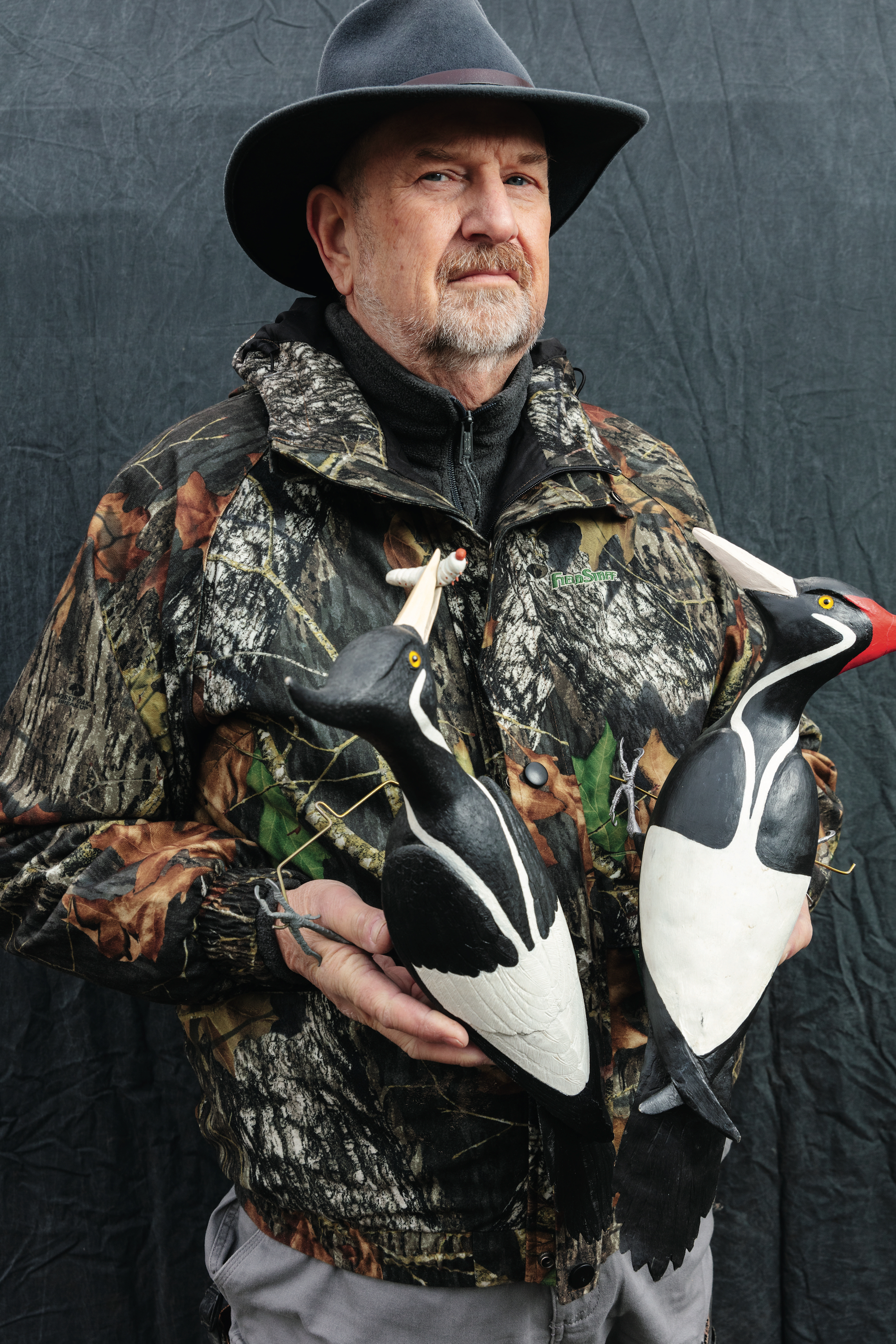
Two ivorybill decoys, a female (left) and male, carved by Harrison.
Now, after almost two decades traversing these waterways, Harrison knows the channels of Bayou De View by heart. As we paddle along, he is patient and cheerful and always armed with a joke, often at his own expense; the irony of a bird photographer not being able to capture on camera the only bird that requires photographing is not lost on him. He hums “Let’s Twist Again,” by Chubby Checker, and now and again calls the hotel to check on Norma, whose health has been deteriorating. We follow blue markers nailed to the trees and weave through the swamp without seeing another soul.
As it turns out, searching for the ivorybill feels exactly like buying a lottery ticket. Rationally, you know it won’t happen, but the if and could of it all—plus the mystery of the deep woods, where anything can be lost or found—keeps your heart racing and your eyes combing the landscape. Birds flit between and behind giant cypresses, whose knees cripple our path, and tupelos obscure the scene. And when two pileated woodpeckers swoop in front of us, an echo of the ivorybill’s majesty reverberates. By the time we pull the canoe out in the late afternoon light, I’m thinking we ought to spin the wheel just one more time. Tomorrow could be the day.
That night, I join Harrison and Norma at a Waffle House. Norma, in a wheelchair and on oxygen, is talkative and observant. Over scrambled eggs and toast, we discuss their children and the room in their house dedicated to all things ivorybill—books, life-size decoys Harrison carved, and souvenirs found on eBay ranging from cigarette silks to an ivorybill-shaped whiskey decanter. Before Norma’s health worsened, they tell me, the couple traveled to every state except Hawaii, often with their children in tow, in pursuit of birds, hiking, and the ivorybill.
“Did you ever get tired of it all?” I ask. She shakes her head. “I knew what I was getting into when I married him,” she says. “The ivorybill was always Bobby’s dream.”
The next day, Harrison takes me to the place in the swamp where, almost twenty years ago, his dream came true.

In his years of most obsessive searching, Harrison had a constant partner: Tim Gallagher, then editor in chief of the Cornell Lab of Ornithology’s Living Bird magazine. Through Harrison’s photography, the two struck up a friendship and eventually discovered that they both chased ivorybills. (“It’s not something you share right away, because people think you’re crazy,” Gallagher says.) They began to travel together to Southern swamps, and to track down all those who had seen the bird, for a book Gallagher was writing. “If this bird really is extinct,” Gallagher reasoned, “these are the last living people who might have a memory of it.” They spoke with James Tanner’s widow, Nancy, and with Fielding Lewis, who in 1971 took two photos of the bird in Louisiana that LSU ornithologist George Lowery championed as real, leading to his public ridicule by those who insisted he’d been fooled by stuffed birds.
Whenever anyone claimed a new sighting, Harrison and Gallagher spoke with them. In February 2004, a man named Gene Sparling reported seeing a huge, funky woodpecker while kayaking in the Big Woods of the Arkansas Delta, at Bayou De View. Gallagher called him up, and then Harrison did the same. The two agreed that his sighting sounded credible. “He said the bird was cartoonish,” Harrison remembers. “And I thought, boy, that’s a perfect description.”
A few days later, Gallagher and Harrison arrived at Bayou De View to meet Sparling. Neither ever tires of telling what happened next. In the afternoon, as the pair searched for a place to camp for the night and Sparling paddled on ahead, a large black-and-white woodpecker burst across their sight line and then turned on edge to weave past a tree, allowing them a full view of its wings. It had the hallmarks of the Grail Bird: white trailing edges on the wings and a fast and straight flight pattern. Stunned, the friends shouted: “Ivorybill!” After the bird disappeared, Harrison called Norma and burst into tears.
Gallagher returned to Cornell and went directly to John Fitzpatrick, the director of the Lab at the time. “Basically, I had to tell him that I’d seen Bigfoot, knowing it could be career death,” Gallagher recalls. “But it was the type of sighting where I didn’t care if I got a picture or not. I saw this bird.” White and shaken, Gallagher relayed his tale. Fitzpatrick did what ornithologists do not normally do with a ghost: He believed.
Fitzpatrick organized a team to travel to Bayou De View in secret, set up camp, and document the bird once and for all with photos, video, recordings, or evidence of a nest. Over roughly twelve hush-hush (and expensive) months, they carefully gathered data. In 2005, they released their best findings: five more sightings, but no photographs, and a video taken by University of Arkansas at Little Rock professor David Luneau that shows an alleged ivorybill peering around a tree, then lighting out into the swamp. The team published a paper in the prestigious journal Science announcing the bird’s rediscovery. News outlets worldwide trumpeted the victory.
But soon, other ornithological heavyweights rejected the evidence. The rediscovery of the ivorybill seemed akin to unearthing treasure—a sensational ecological jackpot that, once claimed, would have to withstand scrutiny. The skeptics asked: How could such an exhaustive survey, conducted by a renowned lab, turn up so little and herald so much? Academic hackles raised, egos ruffled, a counter-paper brewed, and even today, hearing all sides of the story sends a listener ricocheting off one person’s highly opinionated perspective and colliding into another’s. The whole affair spiraled, in the words of Florida Gulf Coast University professor emeritus Jerome A. Jackson, “into biopolitics at its worst.”
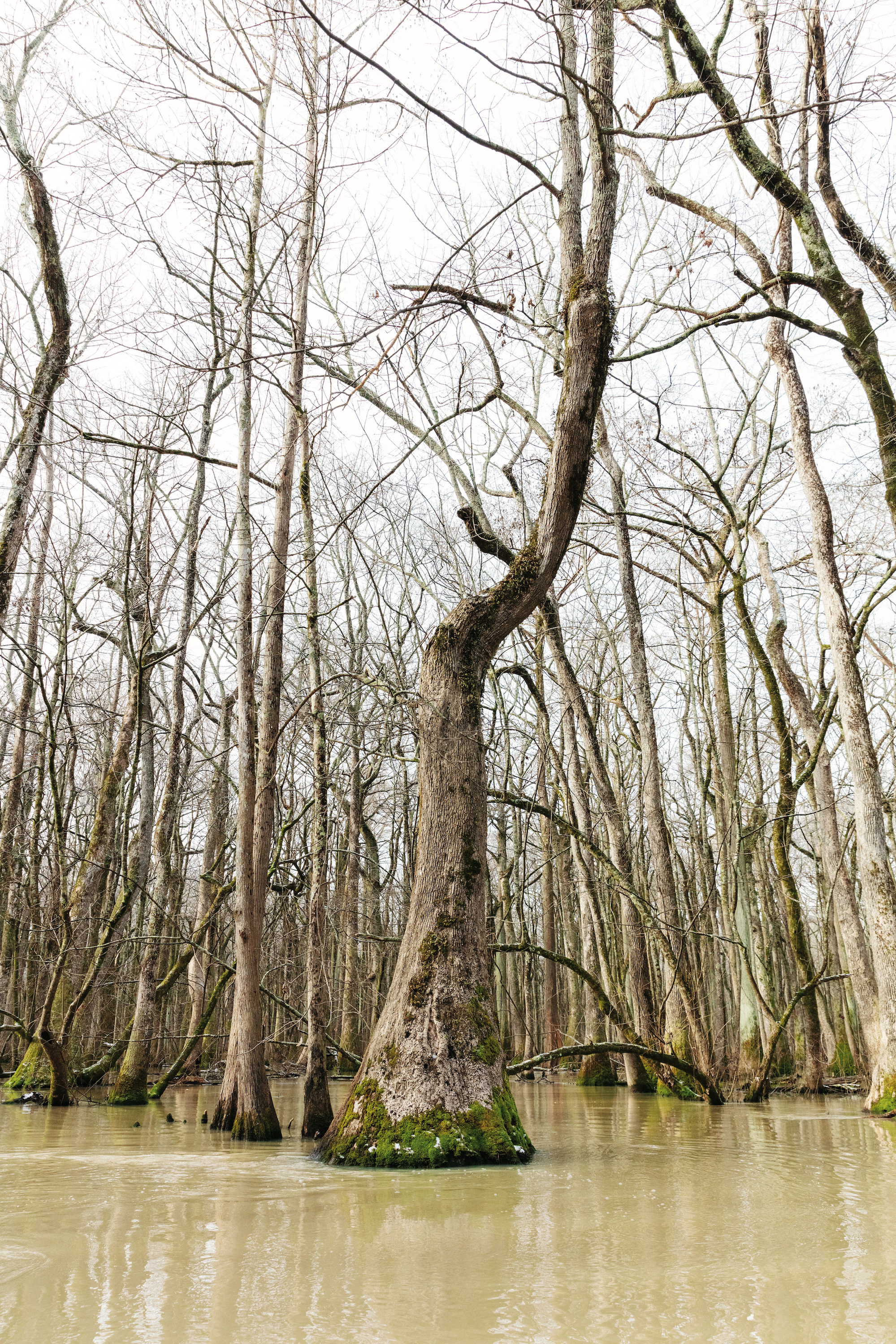
The tree where Harrison and Tim Gallagher claimed to have seen the ivorybill in 2004.
As the scientific community’s leading expert on the ivorybill, Jackson had himself searched for the bird for years, including on a U.S. Fish & Wildlife grant, and wrote a meticulously researched book about its history and cultural role that expressed hope the woodpecker might still exist. But he was not involved in this new search, and he didn’t think the evidence passed muster. “What was coming out of Cornell was faith-based ornithology,” he says. “This is a story of good intentions gone awry and the power of belief amplified by secrecy. A top-notch team of scientists was misled by hope and buoyed by confidence that more searching would bring the definitive photo.”
Despite further expeditions and some promising sound recordings, that doubt-erasing photograph never came. “It was all nonsense,” says Mark Robbins, an ornithologist at the University of Kansas who also rejected Cornell’s findings. “There is no bird on the planet that can’t be photographed today, given our current technology. If you look at the facts, there has been no agreed-upon evidence of this bird since 1944.”
Critics like Robbins and Jackson ultimately believed that Cornell was reaping a lot of publicity from, and spending a lot of precious conservation dollars on, something that possibly didn’t exist: that in a region teeming with endangered species, money should go to species unquestionably still around. And in their view, Harrison and Gallagher, while not necessarily liars, lacked the scientific background necessary to identify the bird. As Robbins puts it, “Believing in the ivorybilled woodpecker is a religion.” In short: There’s disputable, interpretable evidence, maybe, but never proof. And this is not the nebulous realm of faith. This is science.

Today, the frenzy of the 2005 announcement has long since died down. Brinkley, awash for a time with fervent birders, lies nearly silent. And the ivorybill now finds itself at a precarious crossroads, one that has spiked new controversy. On September 30, 2021—ironically, Harrison’s birthday—the U.S. Fish & Wildlife Service proposed to delist the bird’s status due to extinction, along with twenty-two other species, about half of them once found in the South, including the Bachman’s warbler, a fish, and eight mussels.
During the subsequent public comment periods—which the USFWS extended due to “substantial disagreement among experts regarding the status of the species”—Amy Trahan, the agency’s ivorybill species lead, reports more than two hundred entries flooded in from both sides of the issue. A Louisiana group called Project Principalis submitted a pack of evidence, including a drone video featuring a blurry bird. Harrison, who since that first 2004 sighting says he has logged eight more glimpses of the ivorybill, had his own submission.
Harrison had held onto a video since October 2020. That month, at a location he won’t disclose, an ivorybill flew across the channel in front of him. He caught it on his camcorder, and the video shows a large bird zooming through the swamp. “I didn’t go public with it at first, because I know it’s not a high-quality video,” he says. “And grainy, Sasquatch-type videos just hurt the case for the bird.” But with the threat of delisting imminent, he submitted it and presented a frame-by-frame breakdown of why he was convinced it was an ivorybill.
The video’s release divided believers and nonbelievers along their usual lines. Harrison’s blue eyes positively blaze with something between amusement and outrage—skewing toward the latter—when he discusses the nonbelievers’ response to the video. They say it’s a duck, either wood or Muscovy. “They must think I’m really an idiot,” he says, “if I can’t tell a wood duck from a woodpecker.”
More lies at stake, however, than the ivorybill itself. Delisting the woodpecker would strip it of all protections under the Endangered Species Act—including the required conservation of the waterways and forest that make up its habitat. The USFWS’s Trahan, however, doesn’t expect much to change in that case. “Bottomland hardwood forest supports other federally listed or state listed species that would continue to live in those areas,” she says. “So the habitats would still have those protections,” and any lands previously acquired for the ivorybill’s recovery would remain public.
Jim Tate, on the other hand, a former Cornell ornithologist and a former endangered species specialist at the USFWS, holds that delisting could negatively impact Southern swamps, since the ivorybill requires large, continuous tracts of land to thrive. He fears “more bottomland will be developed for other purposes like tourism, recreation, harvest of wood, or creating wetland crops in previously forested areas. All these things will be commodities worth pursuing when nobody has the woodpecker looking over their shoulder.”
Harrison and others—including John Fitzpatrick, the former Cornell Lab director—feel that if there’s even a shadow of a doubt that the bird is not extinct, why delist it? “We have done this bird wrong again and again,” Harrison says. “If we delist it, we’ll do it wrong one final time.”

In November 2022, I text Harrison to plan our next swamp visit. “Call me when you get a chance,” he responds. “I have news.” I phone him immediately. He answers, his voice thick with emotion. “I couldn’t bring myself to text the words. But I just wanted to tell you that Norma passed away. I was with her, here at home.”
I meet Harrison again at Bayou De View a few months later. Though he carries a new sadness, his gentle nature and sense of humor remain. This time, the air and water are cold, but the trees stand naked, and we can see for what feels like miles into the muddy recesses of the swamp. As his camcorder runs, birds appear everywhere. A downy woodpecker, small and jittery, scales a tupelo. A yellow-bellied sapsucker peers at us from a branch, and somewhere deep in the forest rings the hollow, insistent thud of a bill drilling into wood. Overhead, a pileated woodpecker laughs. We pass a tree with promising scaling where Harrison remembers once sitting ready with his camera for two days straight, hoping an ivorybill would pay a visit.
In a stretch with cell phone service, both of his children call to check on him. They’re glad to know their dad isn’t out in the reaches of the swamp alone, as he often is. Occasionally, he quizzes me on which direction we should turn to get back to the main channel. “What are you going to do if I have a heart attack, girl?” he asks, only half joking.

The swamp where Harrison often searches for days at a time can be inhospitable, with boot-swallowing muck, snakes, and disorienting passages.
We navigate through the trees until we arrive at two motion-sensor cameras Harrison mounted months ago. He clambers out of the canoe into the mud to change the memory card, so he can review the photos back at home. Around us the swamp air hangs heavy with possibility. What if he were to go down in history as the one who fulfilled the quest, who finally proved beyond a reasonable doubt, and despite years of derision, that the ivorybill is flesh and blood? “This may be,” he had told me months before, “the only truly important thing I do for the world.”
Later, over dinner, he seems to reiterate that idea. “I believe we have a purpose,” he says. “You end up doing things you’d never thought you’d do, for love.” I think of the dark nights he spent away from his family, the thousands of dollars he’s dropped on supplies and gas, the countless cans of Dinty Moore beef stew he’s eaten while camping, the feeling of freezing water entering a punctured wader. All for the noblest woodpecker of them all. But then: “For a long time now, I’ve thought my purpose was taking care of Norma.”

Species go extinct all the time—most slip in silence out of this world, where they once forged a careful place for themselves, without ceremony or eulogy or mourning. But the ivorybill will not go quietly. Like any we love, it will go with weeping and gnashing of teeth and a litany of mea culpas, because after all, the Lord God Bird has become, through its beauty and its resurrections and its champions, more than a bird—it is a story; a tragedy, a cautionary tale, of how we let a symbol of the South’s wildest, most mysterious heart slip away. And like the ancient mariner who shot the albatross, we are compelled to tell the tale. It haunts us.
What will you do, I ask Harrison, if they declare the ivorybill extinct? At his age, the bulky batteries that power the trolling motor feel heavier. Stepping in and out of the canoe demands more balance. Loading up the van for the five-hour drive to Arkansas takes longer than it once did. “The ivorybill itself isn’t likely to notice that the government declared it extinct,” he answers. “As long as I’m able, I’ll be out here searching.”



